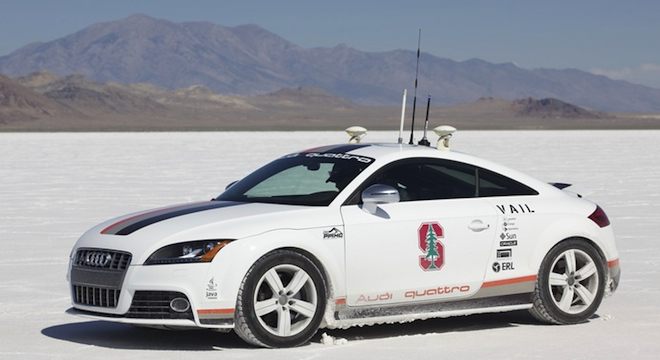Updated 3:35 p.m. ET, Monday, January 7
Toyota and Audi are racing to catch up with Google when it comes to self-driving cars.
On Monday, both auto brands revealed they have been testing their own self-driving cars, or autonomous vehicles. The announcements were timed to coincide with the annual Consumer Electronics Show (CES) in Las Vegas, Nevada, which officially begins Tuesday, January 8.
Audi on its website announced that it has become the second company after Google to receive a permit from the state of Nevada for testing autonomous vehicles on public roads, which it has been doing since December.
The auto company, which is majority owned by Volkswagen, also showed off a video highlighting one of its first successful autonomous vehicle milestones, the 2010 test of a Audi TTS Pikes Peak research car, which successfully completed a 12.42-mile drive through the Hill Climb circuit in Pikes Peak, Colorado, navigating 156 turns without a human driver at the wheel in just 27 minutes:
That test was done on a closed course with the help of researchers at Stanford. Two years later, Audi has moved from a research phase to a “pre-production phase,” and projects that it could be in a position, technologically speaking, to offer at least two specific semi-autonomous systems on customer car models by “the end of the decade,” Audi spokesperson Bradley Stertz told TPM in a phone interview.
The two systems Audi is demonstrating at CES are on an Audi A7 model, and include a “traffic jam” assist that pilots the car in congested, stop-and-go traffic and alerts a driver when the traffic clears enough for them to take over, as well as a “piloted parking” function that allows the car to park itself inside indoor garages, even those where the car can’t get a GPS signal. That system relies on a variety of sensors and is now designed to work with “smart garages” that can provide the car with an indoor map.
“We’ve said that it’s feasible that it could happen by the end of this decade,” Stertz said. “But there are still some significant legal and regulatory challenges that have to be investigated aggressively by both government and industry.”
Specifically, Stertz said the main question was: “What happens if there’s an accident?,” when a computer system is controlling the car, i.e., who is responsible? Stertz said that until regulations became clear on this, commercial viability of autonomous systems could be significantly hampered or even thwarted entirely.
“If these questions don’t get ironed out, it could prove fatal to the whole concept.” Stertz said.
Still, Stertz noted that there could be some variations on full autonomy that would make more sense, at least in the short term, such as “autonomous up to 10 miles an hour,” as an example.
In Audi’s announcement, the automaker pointedly explained that it doesn’t want its computer systems to take over the wheel entirely.
Audi still wants human drivers to be able to step in and take control of the vehicle at any point. As such, Audi compared the two systems it is debuting at CES to the “auto pilot” settings found on modern airlines:
“The term ‘piloted’ is used advisedly, as Audi envisions motorists enjoying the convenience of allowing the car to handle mundane stop-and-go driving conditions, for example, while still being able to take control of the car when needed. In this way, the technology is similar to auto-pilot systems found on jetliners.”
Meanwhile, Toyota on Monday afternoon revealed its own autonomous vehicle “co-pilot” system, tested on its luxury Lexus LS brand.
Toyota published the following images Monday showing sensors strapped to the body of a test vehicle Lexus LS, showing off what the company calls its “Integrated Safety Management Concept”:


“For Toyota and Lexus, a driverless car is just a part of the story,” said Mark Templin, Toyota group VP and Lexus Division manager, in a press statement. “Our vision is a car equipped with an intelligent, always-attentive co-pilot whose skills contribute to safer driving.”
That’s why the world’s largest car company also didn’t go so far to call the system a “self-driving” one, instead noting it was designed to detect a vehicle’s surroundings and help human drivers avoid crashes.
“The vision is not necessarily a car that drives itself,” Toyota’s press release stated. “Instead, Toyota and Lexus envision technologies that enhance the skills of the driver, believing a more skillful driver is a safer driver.”
Toyota’s system uses a 360-degree LIDAR (Light Detection And Range) laser, three high-def color cameras capable of discerning traffic light colors at a distance of about 490 feet (150 meters), and front and side-facing radar, wheel sensors, and on the roof, GPS antennas and an inertial measurements unit.
Toyota said it had been conducting tests of a separate short-wave radio system, the “Intelligent Transportation System (ITS),” which allows cars to communicate with each other and road features and alert a driver to possible collisions and lane changes. In developing this system, the automaker went so far as to build at an 8.6-acre ITS test facility designed to mimic real world traffic conditions at its Higashi-Fuji Technical Center in Susono City, Japan.
Google’s own self-driving car program had logged 300,000 miles of autonomous test driving as of August 2012, the company revealed. Although Google used modified Toyota Prius cars for many of its self-driving tests, the companies aren’t working together on autonomous systems, according to sources who spoke to CNN Money.
The news of Audi’s and Toyota’s autonomous vehicle tests comes just days after Google revealed its popular Google Maps product was being tightly integrated into more vehicle brands in the U.S., including Audi, Hyundai and Kia. Sources with knowledge of the situation have previously told TPM that automakers are wary of Google’s self-driving car ambitions and increasingly having second thoughts about featuring Google Maps in cars as a result.
Updated to add statements from Audi’s Stertz and additional information provided by Audi.






